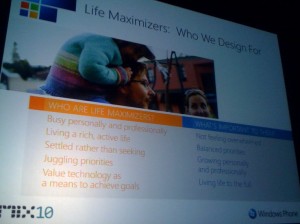MIX10 Day 1 wrap-up: five trends you might have missed

Microsoft has an interesting challenge at a conference like MIX10. The event, now under way in Las Vegas, is aimed at an audience of developers, who are packing into conference rooms for deeply technical nuts-and-bolts sessions on new programming tools and platforms. But there's a second, larger audience looking over their shoulders. This constituency, represented by a large corps of bloggers and analysts (and a few traditional media types), is looking past the tools and code-writing tips for clues about what Microsoft's next generation of gadgets will look like.
Microsoft, to its credit, is making sure to accommodate that larger audience with extensive demos and little bits of news buried in otherwise geeky sessions. Other people have done a good job of documenting the specs and new hardware that were shown off today. Here are five trends I spotted by reading between the lines on those PowerPoint slides:
Apps are crucial. Just making a better Windows phone isn't enough. Apple already defined the standard with its "There's an app for that" mantra. That's why Microsoft is giving away its new developer tools for the Windows Phone 7 platform and trying so aggressively to have lots and lots of apps and games available at launch. There's no way that this platform will be able to catch up with the iPhone ecosystem in the next six months (or ever, perhaps, given the iPlatform's head start), but Microsoft has to have a big selection of apps - thousands, not hundreds - on Day 1. I overheard lots of chatter from developers who seemed eager to start coding.
The Windows Phone isn't for everyone. According to one slide in Microsoft VP Joe Belfiore's presentation, the Windows Phone 7 design is aimed at a group they call "life maximizers." In characteristic Microsoft fashion the design team has created a pair of "personas," Anna and Miles, who are 38 years old, live just outside Chicago, have one child, are "busy personally and professionally" and are "settled rather than seeking." If that sounds a lot like a typical Microsoft middle manager (except for the Chicago part), well... you might be right. But based on that description, this series of phones isn't designed for teens or hipsters. Here's a slightly blurry photo showing these design principles in all their jargon-laden splendor.
A little variety goes a long way. In his overview of the Windows Phone 7 platform today, Belfiore described the chaos that is the current Windows Mobile ecosystem. Most current Windows Mobile devices, as he explained it, were designed by a handset maker and mobile provider trying to serve a narrow slice of the overall market. That led to a hodgepodge of handsets, with widely varying screen sizes, with or without touch capabilities, with or without a keyboard, and powered by a variety of processors, and the OS and apps had to be capable of working on all of them. By contrast, the Windows Phone 7 spec sets some stringent requirements - four-point touch capabilities are a requirement, for example, and only two screen sizes are tolerated. That approach allows for some variety, but within a fairly narrow range. And it reduces the burden on developers, who can test apps against a couple of device types and be confident they'll work on any of the new Windows Phones.
Some sacred cows are being sacrificed. I was thrilled to see an actual price tag, in dollars and cents, attached to the AP Mobile news app in one of today's demos. No big deal, you say? You must not be familiar with Microsoft Points, the hideously confusing payment system Microsoft currently uses for its Zune and Xbox marketplaces. It looks like points are on their way out, and not a moment too soon.
You don't have to copy Apple to succeed. Yes, there are places in the Windows Phone 7 Series platform where you can see features that are clearly from the same gene pool as the iPhone. A marketplace that contains only Microsoft-approved apps? That sounds familiar. But committing to a "transparent" certification process for those apps? That's thinking different.
Any trends I missed? Point them out in the Talkback section.
